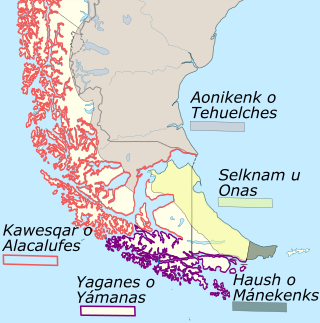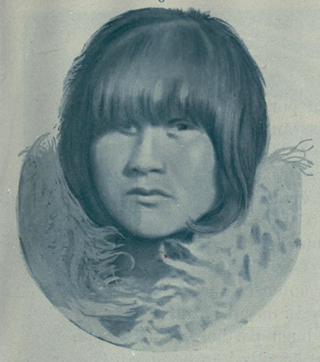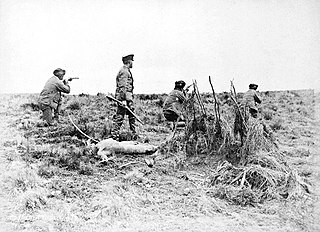
The Selk'nam, also known as the Onawo or Ona people, are an indigenous people in the Patagonian region of southern Argentina and Chile, including the Tierra del Fuego islands. They were one of the last native groups in South America to be encountered by migrant Europeans in the late 19th century. In the mid-19th century, there were about 4,000 Selk'nam; in 1916 Charles W. Furlong estimated there were about 800 Selk'nam living in Tierra del Fuego; with Walter Gardini stating that by 1919 there were 279, and by 1930 just over 100.

The Chonan languages are a family of indigenous American languages which were spoken in Tierra del Fuego and Patagonia. Two Chon languages are well attested: Selk'nam, spoken by the people of the same name who occupied territory in the northeast of Tierra del Fuego; and Tehuelche spoken by the people of the same name who occupied territory north of Tierra del Fuego. The name 'Chon', or Tshon, is a blend of 'Tehuelche' and 'Ona'.

The Yahgan are a group of indigenous peoples in the Southern Cone of South America. Their traditional territory includes the islands south of Isla Grande de Tierra del Fuego, extending their presence into Cape Horn, making them the world's southernmost indigenous human population.

Anne MacKaye Chapman was a Franco-American ethnologist who focused on the people of Mesoamerica writing several books, co-producing movies, and capturing sound recordings of rare languages from the Northern Triangle of Central America to Cape Horn in South America.
Yuracaré is an endangered language isolate of central Bolivia in Cochabamba and Beni departments spoken by the Yuracaré people.

The Tehuelche people, also called the Aónikenk, are an Indigenous people from eastern Patagonia in South America. In the 18th and 19th centuries the Tehuelche were influenced by Mapuche people, and many adopted a horseriding lifestyle. Once a nomadic people, the lands of the Tehuelche were colonized in the 19th century by Argentina and Chile, gradually disrupting their traditional economies. The establishment of large sheep farming estates in Patagonia was particularly detrimental to the Tehuelche. Contact with outsiders also brought in infectious diseases ushering deadly epidemics among Tehuelche tribes. Most existing members of the group currently reside in cities and towns of Argentine Patagonia.

Fuegians are the indigenous inhabitants of Tierra del Fuego, at the southern tip of South America. The name has been credited to Captain James Weddell, who supposedly created the term in 1822.

Ángela Loij López, baptized as Ángela Gómez, was an Argentine-Chilean woman considered to be the last surviving individual of full-blooded Selk'nam (Ona) descent, an indigenous group that resided in Tierra del Fuego.
Puelche was a language formerly spoken by the Puelche people in the Pampas region of Argentina. The language is also known as Gününa Küne, Gennaken (Guenaken), Northern Tehuelche, Gününa Yajich, Ranquelche, and Pampa.

Tehuelche was one of the Chonan languages of Patagonia. Its speakers were nomadic hunters who occupied territory in present-day Chile, north of Tierra del Fuego and south of the Mapuche people. It is also known as Aonikenk or Aonekko 'a'ien.
The Fuegian languages are the indigenous languages historically spoken in Tierra del Fuego by Native Americans. Adelaar lists the Fuegian languages as the Kawésqar language, the Ona language and the Yaghan language in addition to Chono, Gününa Yajich, and the Tehuelche language.
Mosetén–Chon is a proposal linking the Mosetenan languages and the Chonan languages of South America. Kaufman (1990) finds the connection fairly convincing.

The Haush or Manek'enk were an Indigenous people who lived on the Mitre Peninsula of the Isla Grande de Tierra del Fuego. They were related culturally and linguistically to the Selk'nam people who also lived on the Isla Grande de Tierra del Fuego, and to the Tehuelche people of southern mainland Patagonia.

Lola Kiepja was a Selk'nam shaman nationalized as an Argentine, known as "the last Ona" or "the last Selk'nam", due to being the last person of Selk'nam ethnicity to have directly grown up in an indigenous community, having learned their way of life, traditions, religion, and language.
The Teushen language is an indigenous language of Argentina, which may be extinct. It was spoken by the Teushen people, a nomadic hunter-gatherer people of Patagonia, who lived between the Puelche people to their north and the Tehuelche people to the south, who occupied the central part of the Tierra del Fuego region. The tribe is now extinct.

The Selk'nam genocide was the systematic extermination of the Selk'nam people, one of the four indigenous peoples of Tierra del Fuego archipelago, in the late 19th and early 20th centuries. Historians estimate that the genocide spanned a period of between ten and twenty years, and resulted in the decline of the Selk'nam population from approximately 4,000 people during the 1880s to a few hundred by the early 1900s.
The Haush language was an indigenous language spoken by the Haush people and was formerly spoken on the island of Tierra del Fuego. The Haush were considered the oldest inhabitants of Tierra del Fuego; they inhabited the far eastern tip of the Mitre Peninsula. They made regular hunting trips to Isla de los Estados.

Thomas Bridges was an Anglican missionary and linguist, the first to set up a successful mission to the indigenous peoples in Tierra del Fuego, an archipelago shared by Argentina and Chile. Adopted and raised in England by George Pakenham Despard, he accompanied his father to Chile with the Patagonian Missionary Society. After an attack by indigenous people, in 1869 Bridges' father, Despard, left the mission at Keppel Island of the Falkland Islands, to return with his family to England. At the age of 17, Bridges stayed with the mission as its new superintendent. In the late 1860s, he worked to set up a mission at what is now the town of Ushuaia along the southern shore of Tierra del Fuego Island.
Selk'nam mythology is the body of myths of the Selk'nam and Haush peoples of Tierra del Fuego.












